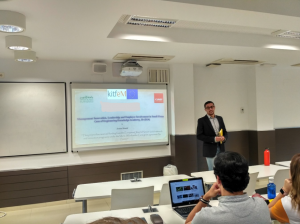![]()
KITFEM PROJECT. MSCA RISE
Employees and innovation: a case study
On 21st of September, students at CUNEF participated in a seminar given by Souhail Ramid, researcher at Al Akhawayn University (Morocco). Souhail spent three months at CUNEF to work together with Prof Dr Sylvia Rohlfer on research about employees´ influence over firm´s innovation capabilities. Students discussed the results of a case study he had conducted over the summer on a smaller Italian enterprise operating in a global sector and with recognized innovation results.
This project has received funding from the European Union´s Horizon 2020 research and innovation program under the Marie Sklodowska-Curie grant agreement No 734447 (#KITFEM)
KITFEM Project Website
Since the rise of emerging economies in the global scenario, it has been critical to better understand the role of knowledge and innovation played in this process. We focus on researching not only how knowledge and innovation is managed and generated in emerging markets, but also how traditionally they learned from advanced economies to enhance their innovation capability, and recently the reverse innovation process about how this innovation capability in emerging markets affects and is transferred to advanced economies.
KITFEM Project objectives
Based on these premises and purposes, K.I.T.F.E.M. project aims to pool EU and emerging markets’ competences and on-going research efforts to carry out a comprehensive, multidisciplinary and multi-level investigation, aimed at analyzing the role and the interplay of the main factors that characterize knowledge management, innovation and competitiveness in, to and from emerging markets and the projected impacts on EU innovation strategies and policies, as well as exchanging, training and diffusing knowledge and innovation among academic and nonacademic sectors. Therefore, the main questions for the RISE research exchange and the joint scientific activities planned are specified in the following:
1. How do international knowledge transfer, new technology and business models innovation and implementation work with (in, to and from) emerging markets? How do these factors impact on emerging countries (i.e. Argentina, China, Mexico, Morocco, or Vietnam in this project) enterprises’ innovation capabilities? How do these factors interact with each other and how can these interactions affect EU enterprises’ innovation capabilities?
2. How does collaborative innovation among different stakeholders emerge and succeed in advanced economies and emerging markets? What are the strategic factors in influencing knowledge transfer and innovation in advanced economies and emerging countries enterprises? What is the role of cultural difference played in this process? Finally, how do these factors affect knowledge, innovation and overall firm performance?
3. Which are the challenges for organizations and their workforce when involving employees for increasing firm innovativeness? What forms of employee participation are used and what is the causal relationship between employee participation and involvement and firm’s innovation performance? What are the contextual conditions in emerging markets under which different forms of employee participation evolve and feed into a firm’s innovation performance, especially in comparison with these in advanced economies in the EU?
4. How do expatriate management practices facilitate knowledge management and innovation creation? How do different types of expatriate management practices interrelate and systematically mediate the duality of innovative capability? Which mechanisms push employees to create new ideas/start-up? Which processes are necessary for a new product/service creation?
5. Are there significant relationships among international knowledge and technology transfer process, collaborative innovation, employment relations, and expatriate management, which affects firms’ strategies and institutional policies for EU and emerging countries, both in terms of knowledge creation, innovation and overall firm performance? If so, what can these relationships tell about emerging countries’ path to technology and business innovation? Last but not least, what are the actual and potential impacts of a strengthened innovation capacity of these emerging countries on EU enterprises’ strategies and innovation policies? How can local policies, following specific EU sectorial strategy, affect businesses in the knowledge and technological transfer process?
While the specific objectives are to be transferred into specific work package (the state of art of each research field within the study question will be detailed in each work package in the section 3) to work with, the final aim of the proposed exchange schema is also to create the nucleus of a unique network of European and emerging countries’ (i.e. Argentina, China, Mexico, Morocco and Vietnam) knowledge and innovation scientists, universities and research centers, along with the participation of non-academic sector, to better connect with and contribute to the ampler society. This nucleus will be capable to facilitate scientific collaboration based on the realization of joint research and training programs, the mobility of researchers and their projects between EU and emerging countries.
https://cunef.edu/web/kitfem


Very Thanks to you, your article is very useful for all